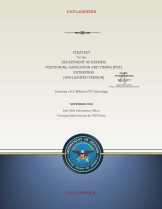Library
Home »Resources and References
Scope of this Library
RNT Foundation is an educational and scientific charity, most concerned with policy decisions that impact navigation and timing resiliency. Much has been written and said on the topic and the field continues to develop rapidly, especially with regard to technologies. Any attempt at a comprehensive library would be foolhardy. That said, if you have or know of documents that you think are important to include in this library, please send us a link or email us the document.
We hope that this library will provide you with convenient access to some of the more important documents in the field and provide assistance if you need to search for others. Please read our disclaimer.
Browse Our Library
RNTF Corporate Documents
Board of Directors and Annual Meeting Minutes 2023
1-6-2023 RNTF Board Meeting Minutes 2-20-2023 RNTF Board Meeting Minutes 5-26-2023 RNTF Board Meeting Minutes 9-21-2023 RNTF Board Meeting Minutes 12-15-2023 RNTF Board Meeting Minutes 2023 RNTF Annual Meeting Minutes 4 May
Board of Directors and Annual Meeting Minutes 2022
The Annual Meeting for 2022 will be held in Nov-Dec after the PNT Advisory Board Meeting. 2-9-2022 RNTF Board Meeting Minutes 5-2-2022 RNTF Board Meeting Minutes 7-8-2022 RNTF Board Meeting Minutes - Pending Final
Board of Directors and Annual Meeting Minutes – 2021
1-6-2021 Board of Directors Meeting Minutes 3-15-2021 Board of Directors Meeting Minutes 6-4-2021 Board of Directors Meeting Minutes 9-15-2021 Board of Directors Meeting Minutes 12-6-2021 Board of Directors Meeting Minutes Annual Meeting 12-10-2021 Minutes ...
Board of Directors & Annual Meetings – Minutes 2020
1-15-2020 Board Minutes Final 4-3-2020 Board Minutes Final 6-11-2020 Board Minutes Final 9-11-2020 Board Minutes Final 10-13-2020 Board Minutes Final 2020 Annual Meeting 5-5-2020 Minutes Final Resolution to support David Last Memorial Scholarship 1-15-2020...
Board of Directors & Annual Meetings – 2019 Minutes
2-11-2019 Board Minutes Final 4-3-2019 Board Minutes Final 5-13-2019 Board Minutes Final 6-24-2019 Board Minutes Final 9-9-2019 Board Minutes Final 11-13-2019 Board Minutes Final RNTF Annual Meeting Minutes 7 June 2019
Board of Directors Meeting Minutes – 2018
3-5-2018 Board Minutes Final 5-15-2018 Annual Meeting Minutes 5-29-2018 Board Minutes Final 9-7-2018 Board Minutes Final 10-18-2018 Board Minutes Final 12-18-2018 Board Minutes Final Resolution Stipend for President 3-5-2018
Board of Directors Meeting Minutes – 2017
1-11-2017 Minutes Final 2-7-2017 Minutes Final 3-8-2017 Minutes Final 5-8-2017 Minutes Final 6-1-2017 Minutes Final 6-27-2017 Annual Meeting Minutes Final 8-1-2017 Minutes Final 9-28-2017 Minutes Final 12-4-2017 Minutes Final Public Info & Social Media Resolution...
Board of Directors Meeting Minutes – 2016
1-14-2016 Minutes Final 2-4-2016 Minutes Final 3-3-2016 Minutes Final 4-5-2016 Minutes Final 5-15-2016 Minutes Final 6-1-2016 Minutes Final 7-12-2016 Minutes Final 8-10-2016 Minutes Final 9-13-2016 Minutes Final 10-11-2016 Minutes Final 11-9--2016 Minutes Final...
Board of Directors Meeting Minutes – 2015
1-13-2015 RNTF Minutes Final 2-9-2015 RNTF Minutes Final 3-9-2015 RNTF Minutes Final 4-8-2015 RNTF Annual Mtg Minutes Final 5-14-2015 RNTF Minutes Final 6-10-2015 RNTF Minutes Final 7-6-2015 RNTF Minutes Final 8-18-15 RNTF Minutes Final 9-16-2015 RNTF Minutes Final...
Board of Directors Meeting Minutes – 2014
3-6-14 RNTF Board Minutes 4-22-14 Record of Annual Meeting 4-7-2014 RNTF Board Minutes 6-11-14 RNTF Board Minutes 5-12-14 RNTF Board Minutes 7-10-14 RNTF Board Minutes 8 -7-2014 RNTF Board Minutes 9-24-14 RNTF Board Minutes 10-15-14 RNTF Board Minutes 11-13-14 RNTF...
Board of Directors Meeting Minutes – 2013
8-22-13 RNT Board Minutes 9-2-2013 Board Action 10-3-13 RNT Board Minutes 11-7-13 RNT Board Minutes 12-16-13 RNT Board Minutes
RNT Foundation Articles of Incorporation, other Corp Documents Establishment in 2013
RNT Foundation - filed Articles of Incorporation - Click Here 8-20-13 RNT Foundation Action Without Meeting - Click Here
RNT Foundation Bylaws – Last Amended 13 May 2019
RNT Foundation Bylaws as of 13 May 2019 Click Here
Disclaimer: All the documents in this library not created by RNT Foundation were publicly available on the internet at the time of posting. For cases where the author’s intention to have document made public was not entirely clear, we have obtained their agreement to the posting. RNT Foundation takes no responsibility for the statements of and views expressed in any non-foundation document.



